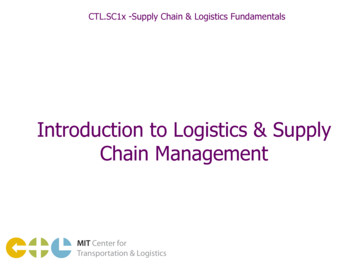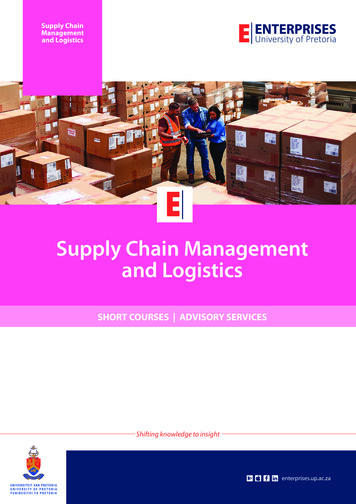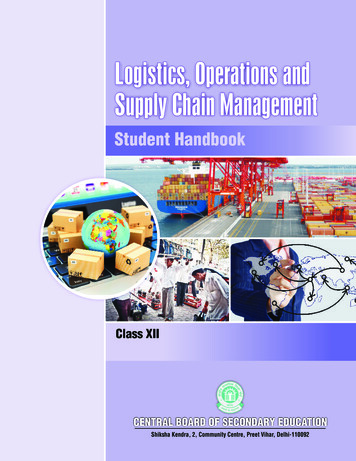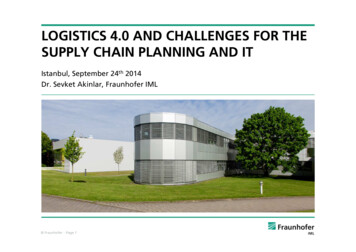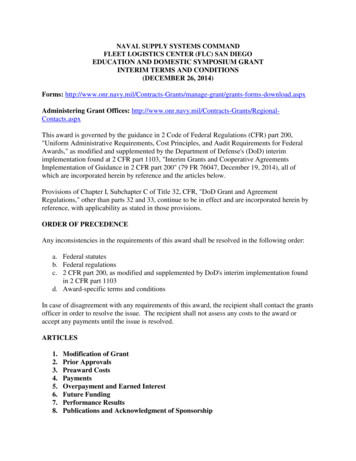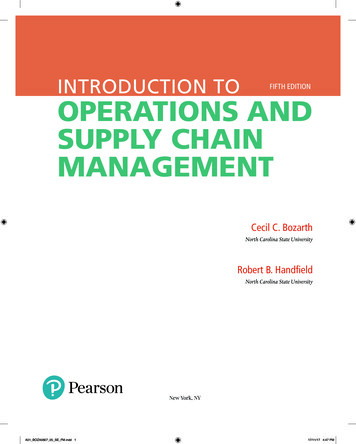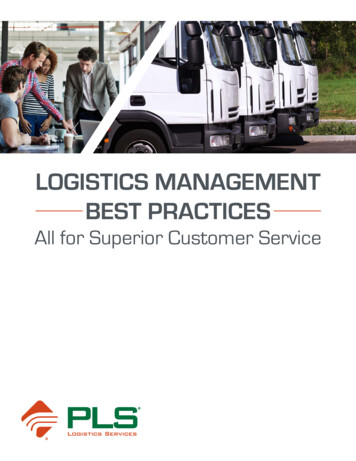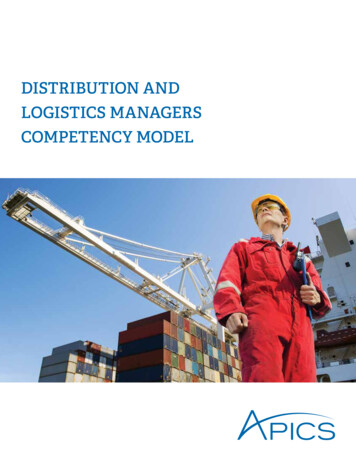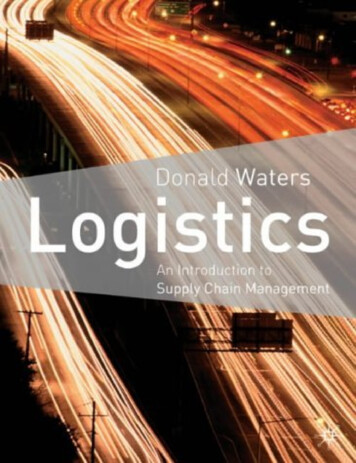
Transcription
Logistics
LogisticsAn Introduction to SupplyChain ManagementDonald Waters
Donald Waters 2003All rights reserved. No reproduction, copy or transmission of thispublication may be made without written permission.No paragraph of this publication may be reproduced, copied or transmittedsave with written permission or in accordance with the provisions of theCopyright, Designs and Patents Act 1988, or under the terms of any licencepermitting limited copying issued by the Copyright Licensing Agency, 90Tottenham Court Road, London W1T 4LP.Any person who does any unauthorised act in relation to this publicationmay be liable to criminal prosecution and civil claims for damages.The author has asserted his right to be identified as the author of this workin accordance with the Copyright, Designs and Patents Act 1988.First published 2003 byPALGRAVE MACMILLANHoundmills, Basingstoke, Hampshire RG21 6XS and175 Fifth Avenue, New York, N.Y. 10010Companies and representatives throughout the worldPALGRAVE MACMILLAN is the global academic imprint of the PalgraveMacmillan division of St. Martin’s Press, LLC and of Palgrave Macmillan Ltd.Macmillan is a registered trademark in the United States, United Kingdomand other countries. Palgrave is a registered trademark in the EuropeanUnion and other countries.ISBN 0–333–96369–5 paperbackThis book is printed on paper suitable for recycling and made from fullymanaged and sustained forest sources.A catalogue record for this book is available from the British Library.Library of Congress Cataloging-in-Publication DataWaters, C. D. J. (C. Donald J.), 1949–Logistics : an introduction to supply chain management / Donald Waters.p. cm.Includes bibliographical references and index.ISBN 0–333–96369–5 (paper)1. Business logistics. 2. Industrial management. I. Title.HD38.5 .W384 2002658.5—dc212002073544Editing and origination by Aardvark Editorial, Mendham, Suffolk10 9 8 7 6 5 4 3 2 112 11 10 09 08 07 06 05 04 03Printed in Great Britain byAshford Colour Press Ltd, Gosport
To Dan and Sue
ContentsList of FiguresPrefaceixxi4PART IIntroduction1132The Context of LogisticsIntroductionDefinitionsThe Supply ChainActivities of LogisticsAims of LogisticsImportance of LogisticsDiscussion QuestionsReferencesFurther Reading447121719252626Integrating the Supply Chain27Progress in LogisticsCurrent Trends in LogisticsIntegrating Logistics Within anOrganisationIntegration Along the Supply ChainAchieving IntegrationDiscussion QuestionsReferences28305634394353547PART IIPlanning the Supply Chain573Logistics Strategy59Strategic DecisionsLogistics StrategyStrategy OptionsDesigning a Logistics StrategyDiscussion QuestionsReferences606266738080Implementing the Strategy82Relating Strategy to Lower DecisionsAreas for Decisions in ImplementationManaging ChangeDiscussion QuestionsReferences838595103103Locating Facilities104Importance of LocationChoosing the Geographic RegionInfinite Set ApproachesFeasible Set ApproachesNetwork ModelsLocation PlanningDiscussion QuestionsReferencesFurther Reading105109113119126130136136136Planning Resources137Types of PlanningCapacity PlanningAdjusting CapacityTactical PlanningShort-term SchedulesDiscussion QuestionsReferencesFurther Reading138139144150158165165165Controlling Material Flow166Material Requirements PlanningExtending the Role of MRPPrinciples of Just-in-timeAchieving Just-in-time OperationsExtending JIT Along the Supply ChainDiscussion QuestionsReferencesFurther Reading167174178183189194194195
viii8CONTENTSMeasuring and ImprovingPerformance19611Measuring PerformanceComparing PerformanceAnalysing a Supply ChainImproving PerformanceDiscussion QuestionsReferencesFurther Reading197207209215222223223PART IIIActivities in the Supply Chain910225Procurement227DefinitionsChoosing SuppliersProcurement CycleTypes of PurchaseDiscussion QuestionsReferencesFurther Reading228232236242249249250Inventory Management251Reasons for Holding StockEconomic Order QuantityUncertain Demand and Safety StockPeriodic Review SystemsEffort of Stock ControlDiscussion QuestionsReferencesFurther g and MaterialHandling282Purpose of WarehousesActivities Within a WarehouseOwnershipLayoutMaterials HandlingPackagingDiscussion QuestionsReferencesFurther oductionMode of TransportIntermodal TransportOwnership of TransportRouting VehiclesDiscussion QuestionsReferencesFurther Reading309310319321325331331331Global Logistics332International TradeProblems with International LogisticsOrganising International OperationsDiscussion QuestionsReferencesFurther Reading333338342349349349350
List of 2.32.42.5Summary of logistics activitiesThree levels of logistics integrationVarying demandSpectrum of relationshipsDifferent levels of vertical 33.44.14.24.34.4Types of strategic decisionRole of logistics managers in strategicdecisionsDifferent amounts of input fromlogistics managersFactors in the design of a logisticsstrategyLevels of decision in logisticsStructure of a supply chainDifferent shapes of supply chainSimplified supply chain fordistributing shoes55668994.5Spectrum of productsOperations creating outputsCycle of supply and demandThe role of logisticsOutline of the supply chain for paperActivities in a supply chainSupply chain around a manufacturerUsing intermediaries to simplify thesupply chainExamples of organisational structureInfluence of logistics on 5.145.155.16Capacity of a supply chain set by thebottleneckSummary of logistics at RalstonEnergy Systems s.r.o.Deming wheelRate of performance improvementBreak-even analysis for location ofWarwick SuppliesHierarchy of decisions for locationsAlternative choices of locationVariation in transport cost withlocationCalculation of centre of gravityLocations for van Hendrick IndustriesWeakness of the centre of gravitymethodMap for Bannerman IndustriesComparison of sitesVariation in transport cost withnumber of facilitiesFinding the optimal number offacilitiesMap of Ian Bruce’s problemSpreadsheet of calculations forIan BruceRoad network showing travel timein minutes between locationsSolution to the covering problemNetwork for Problem 29129135
57.67.77.88.18.28.38.48.58.68.78.88.98.108.11LIST OF FIGURESAn approach to planning logisticsThe bottleneck of a supply chainlimits the capacityCapacity of distribution at J&RSoftdrinksAlternative timing of capacityexpansionAlternative size of capacity expansionA typical learning curveCost of maintenanceAn iterative approach to planningGraphical approach to planning –plotting cumulative demand andsupplyRevision of plans during cyclesSpreadsheet to help with planningin Piotr HucekComparison of stock levelsPart of a bill of materials for a tableSummary of MRP procedureA closed-loop MRP systemEnterprise resource planningStock levels with different types ofcontrolThe simplest form of message for JITA two-card kanban systemCapacity and utilisation in a supplychainStructure of the UK frozen foodindustrySteps in benchmarkingAn informal process chartFormat for a process chartPart of a process chart for deliveriesat a supermarketPrecedence diagram, with activityB following activity APrecedence diagram for workedexampleExample of a multiple activity chartMultiple activity chart for workedexamplePart of a simulation for Ed’s Drivethrough Bottle 701751771801851869.3Aggregate stock as a percentageof GDP for the UK10.2 Types of stock10.3 Repeated pattern of stock cycles10.4 Variation of cost with order size10.5 Using a reorder level to time orders10.6 Order patterns when lead time islonger than stock cycle10.7 The cost curve is shallow aroundthe economic order quantity10.8 Safety stock raises the averagestock level10.9 Alternative approaches to ordering10.10 Order placed at A has to coverdemand until B10.11 Typical results for an ABC analysis10.12 Original supply chain for 721111.821221422123423724610.1199213213Relative power of a customer anda supplierOutline of steps in a procurementcycleSome arrangements for delivery12.112.212.312.4Using warehouses to reducetransport costsMeeting demand with a mixtureof private and public warehousesBreak-even analysis for public/private warehousesBasic layout of a warehouseSchematic of a common warehouselayoutLayout of paint in worked exampleChoice of automation andwarehouse sizeOutline of Handemann Group’swarehouseFreight moved by transport modein the UKTransporting coal across CanadaThe travelling salesman problemSolution to routing 92293293296300301311318326328
PrefaceSUBJECTThis is a textbook about logistics. It describes the way that materials move into an organisation fromsuppliers, through the operations within an organisation, and then out to customers. As you can see,we take a broad view of logistics, looking at every kind of ‘organisation’, moving every kind of ‘material’. We talk about manufacturers moving tangible goods – and service providers moving materialsfor their intangible services.Every organisation needs a reliable flow of materials. Logistics is an essential function, andmanagers have to make the movement of materials as efficient and effective as possible. This is bestdone by an integrated function that is responsible for all aspects of material movement. The resultsare important, as they directly affect customer service, costs – and just about every other measureof performance.Logistics is not contained within an organisation, but has a unique position in linking externalsuppliers and customers. Organisations increasingly recognise that they do not work in isolation, butform part of a supply chain whose aim is to satisfy customers. To emphasise this broader role, somepeople prefer to talk about ‘supply chain management’.This is a particularly fast-moving field. Developments in operations – such as just-in-time, lean operations, efficient customer response, enterprise resource planning, e-commerce, globalisation, andincreasing customer service – are rapidly changing the demands on logistics. This book gives an up-todate view of logistics, emphasising current trends and developments. It covers important issues, such as: increasing strategic importance of logisticsglobal operations and increasing international competitionintegration of organisations and activities in the supply chainchanging requirements from logistics to deal with new types of operationsbetter communications allowing closer co-ordination of movementsnew requirements from aspects of e-commerceincreasing emphasis on quality and customer-based serviceenvironmental concerns.APPROACH OF THE BOOKThe book gives an introduction to logistics. It can be used by anyone who is meeting the subject for thefirst time. You might be a student taking a course in business studies, or another subject that needssome knowledge of logistics – or you might read the book to learn more about a central area of manage-
xiiP R E FA C Ement. The book gives a broad description of logistics, covering all the main concepts. Itdiscusses the topics in enough depth to provide material for a complete course, but it does notget bogged down in too much detail. By concentrating on key issues, we have kept the text toa reasonable length.The book has a number of features. It: is an introductory text and assumes no previous knowledge of logistics or experience ofmanagementcan be used by many types of student, or people studying by themselvestakes a broad view, covering all types of organisationsets logistics within its strategic contextdescribes a lot of material, concentrating on topics that you will meet in practicedevelops the contents in a logical orderis practical, presenting ideas in a straightforward way, avoiding abstract discussionsillustrates principles by examples drawn from international organisationsincludes a range of features, including chapter aims, examples of logistics in practice, casestudies, projects, worked examples, chapter reviews, problems, discussion questions anduseful readings is written clearly, presenting ideas in an informative and easy style. CONTENTSThe book follows a logical path through the decisions of logistics. An obvious problem is thatthe topics are all related, and decisions are made simultaneously rather than consecutively. Inthe book we effectively have to make a linear journey through a complex web of material. Tomake this easier, we have divided the book into three parts. The first part gives an overallintroduction to logistics. It defines key terms, discusses the role of logistics, its aims, importance, trends and the general context of supply chain management. It shows how logistics hasdeveloped into a single, integrated function.The second part looks at the planning for a supply chain. This starts with the design of alogistics strategy, and then shows how this strategy can be implemented. Important decisionsinclude the structure of the supply chain and the location, number and size of facilities. Thesedecisions lead to lower level plans to organise activities and resources. The supply chain keepschanging, so we look at ways of measuring and improving the performance of logistics.The third part of the book focuses on some specific functions of logistics, includingprocurement, inventory management, warehousing, transport of materials and internationallogistics.Together these chapters cover some of the most important decisions made in anyorganisation.CONTACTSIf you have any comments, queries, requests or suggestions for the book or associated material,the author and publisher would be very pleased to hear them. You
Logistics : an introduction to supply chain management / Donald Waters. p. cm. Includes bibliographical references and index. ISBN 0–333–96369–5 (paper) 1.
